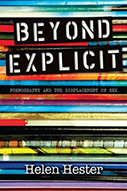Beyond Explicit: Pornography and the Displacement of Sex

Author: Helen Hester
Publisher: New York: State University of New York Press, 2014. 242p.
Reviewer: Melissa Hamilton | May 2014
A new academic genre has emerged known as Porn Studies, a cross-disciplinary research subject that seeks to expand and enlighten critical discussion about pornographies, their meanings, and ramifications. Porn Studies seeks to transcend the simplistic and often dichotomous perspective of viewing pornography holistically as either good or evil, which was the common perspective of the pornography debates amongst feminists in the 1970s and 1980s. In a smart new book, titled Beyond Explicit: Pornography and the Displacement of Sex, Helen Hester grounds her research more specifically in the field of cultural studies, though the text exhibits a linguistics tone too, as the author seeks to expand upon what the term pornography has come to mean and how recognizing such an extension renders various cultural consequences as a result.
At the start, Hester lauds Porn Studies scholars for their efforts in observing and investigating various genres of sexual pornographies, in minimizing generalizations of pornography as a monolithic cultural being, and by studying specific texts toward teasing out their own particular representations. Contemporary porn scholars are also correct in being concerned about censorship and repression in the face of recent instances of high-profile obscenity prosecutions in the United States and new legislation passed in the United Kingdom to broaden the scope of material constituting illegal pornographic images. Yet, she also chastises the current state of Porn Studies for being too narrowly focused on a progressive, anti-censorship agenda that contextualizes pornographies in a too plenary manner as positively promoting political and liberating causes. As examples, she cites academics valorizing any pornography involving sexual minorities.
Hester’s ambitions are several. One is to push Porn Studies further away from partisan imbalances toward adopting more critical attitudes and from engaging merely heterosexist and phallocentric concerns. She advances the academic acceptance of envisioning new variations in pornographies outside those myopically focused on materials produced for, and consumed to achieve, sexual gratification. Hester seeks, as well, to improve Porn Studies’ engagement with visual representations as objects of analysis by contemplating the possible significance of written texts and other nonvisual forms of media. Hence, this is a book that is intent not just on its immediate subject matter, but seeks to be more innovative by expounding upon the potential future of a recently created academic subgenre within social sciences.
Beyond Explicit conceptualizes “porn” as being artfully used in popular culture to embrace and envelope various pseudo-pornographies in which their underlying representations and objectives are not necessarily sex centric. New visions using the moniker of porn have emerged, including so-called medical porn, war porn, torture porn, and misery porn. The claim is that the term pornography has in contemporary Western culture lost its lodestone of being primarily sexual in nature and intent. In other words, the thesis is that pornography includes but is no longer limited to the sexual. To justify this displacement of sex from pornography, Hester teases out and explores during the course of the text four rhetorical devices: transgression, intensity, prurience, and authenticity.
Part I (Feminism, Pornography, Transgression) provides an historical accounting in which the feminist sex wars of the 1970s and 1980s linked sexuality with violations of cultural norms and, as a result, conflated discourses on feminism, pornography, and transgression. Anti-pornography feminists vociferously characterized pornography as necessarily the invention of powerful men to undermine the bodily integrity and legitimacy of women and, therefore, deemed pornography, on the whole, the moral and often physical equivalent of rape. In contrast, a pro-sex feminist voice contended at the time that the availability of pornography could benefit women by allowing them to embrace sexuality such that sexual representations were transgressive in the sense of fostering female rebellion against social norms strictly limiting concepts of gender and sexuality. Interestingly, Hester observes that these two feminist positions, pro-porn and anti-porn, were not always adverse in that both positions sought to reinvent sexual activities as more egalitarian exchanges, markedly with less oppression to women and sexual minorities.
Hester contends that porn imagery has exploded the definition of pornography into representations that disgust rather than sexually titillate. She points to the rise of pornographic materials, for example, incorporating into sex scenes the production and consumption of bodily fluids, waste, and other human emissions that are not inherently, or at least historically, considered sexual in nature. Viewers and readers may be lured by the allegedly sexual nature of these materials, but it becomes clear the intent of the producers of this type of material, being both quasi-sexual and disgusting in content, is to elicit strong, usually negative, affectations. Here, Hester begins to broaden the definition of porn to other areas outside the sexual, introducing the reader to the genre she terms medical porn, being the new media where hosts boldly discuss and blatantly show explicit depictions of all sorts of embarrassing bodily ailments and revolting bodily functions, which is conceptualized in the book as feeding prurient interests.
Part II (Intensity and Prurience: Pornography Without Sex) moves forward by encapsulating within pornography other, non-sexually centric representations and responses. These include war porn and torture porn, specifically certain provocatively horrid images circulating the internet during the recent international skirmishes in the Mid-East. War porn embodies a hybrid version involving porn actors dressed as Western soldiers raping purportedly Iraqi women. Torture porn represents the less sexualized but still evocative portraits of often partly clad dead bodies or disembodied limbs of Afghan insurgents, along with other torturous depictions of enemy combatants designed to instigate and mock prurient interests. The violence of war porn and torture porn, whether with or without obvious sexual content, intersects with the former anti-porn feminists of decades ago who deemed sexual pornography as a whole to aggrandize violence. In this way, Hester justifies the cultural “slippage” of the sexual from the adjective pornographic. At this point in the text, Hester makes her original contribution to Porn Studies, suggesting a redefinition of pornography to mean “something related to the body in a state of intensity, rather than to the body in a state of physiological sexual arousal” (p. 123).
Part III (Pornography and the Real) evokes the fourth factor in this reconceptualization of pornography as involving presentations that strive for an authenticity effect, as in attempting to reflect reality. In this section, Hester reimagines porn to include the genre of what she names misery porn, meaning autobiographical accounts of the authors’ own sufferings and travails, often entailing abuse by the hands of others. Despite potential assumptions that in this post-modern world the abilities of technological media has usurped the real with simulations, Hester counters that such artistry actually has made us even more obsessed with real bodies and all they physically produce. Returning to the traditional definition of pornography, Hester accounts for the proof of authenticity in the focus of pornographic imagery on the erect and ejaculating penis as the surest sign of true sexual arousal and physical intensity. For misery porn, the argument for the authenticity effect is connected to the strident disappointment consumers emote when a purportedly true account of the author’s suffering is revealed as fraudulent and fictional.
In the end, Beyond Explicit acknowledges that drawing anew the boundaries of the pornographic may have nefarious consequences if it is utilized in legislation banning pornographic or obscene materials. Still, the author believes the book achieves what it set out to do—challenge Porn Studies as a discipline to achieve new heights, to refrain from judging pornography as necessarily good or evil, and instead to engage a critical and uncondescending perspective. Hester thus refuses, justifiably, to make any definitive conclusions as to the value of the cultural artifacts she explores (e.g., medical porn, misery porn) to Anglo-western society and culture.
Beyond Explicit is exhaustively researched and is full of frank and colorful imagery. The text contains many exchanges constituting a refined and careful dissection of specific pornographic texts and films. The author succeeds in her stated goal of lending a nonjudgmental and critical perspective and certainly extends Porn Studies in an unexpected direction by broadly reimaging pornography as a new cultural contrivance. In the end, though, I am not convinced of the need or the advantage to this reinvention of pornography outside the sexual. Her term appears too generic, losing all the wonderfully evocative connotation of the centuries-old view of pornography as necessarily directed toward human sexuality on public display. Instead, the commonality among her various porn “types” seems to lie instead in interpersonal violence and bodily functions. This does not mean that there are not valid and justifiable purposes of drawing the connections amongst these stylized works, but this could have been presented as a well-respected cultural exercise (as it does so qualify), but accomplished without the linguistic bent on exploding the definitional boundaries of the term pornography. Hester has sufficiently justified the three factors that influence how we perceive and discuss contemporary images of stylized violence, being transgression, intensity, and prurience, but the fourth characteristic involving the authentic appears less credible. Much of (sexually) pornographic materials freely circulating the internet today, for instance, do not seem to even try to appear realistic in terms of representing the sexual activities of the common public or even with how the actors (or avatars in the digital world) actually feel in the scenes.
Finally, the prose is intellectual and smart, but conveyed in a manner unlikely to be accessible to non-academic readers. Stylistically, I found the text to be too heavily laden with references naming a plethora of other scholars and their works are too frequently quoted. At times the text read as a series of quoted passages. Nonetheless, despite these critiques, this is a valuable addition to Porn Studies and a fine example of an engaging scholarly argument.


